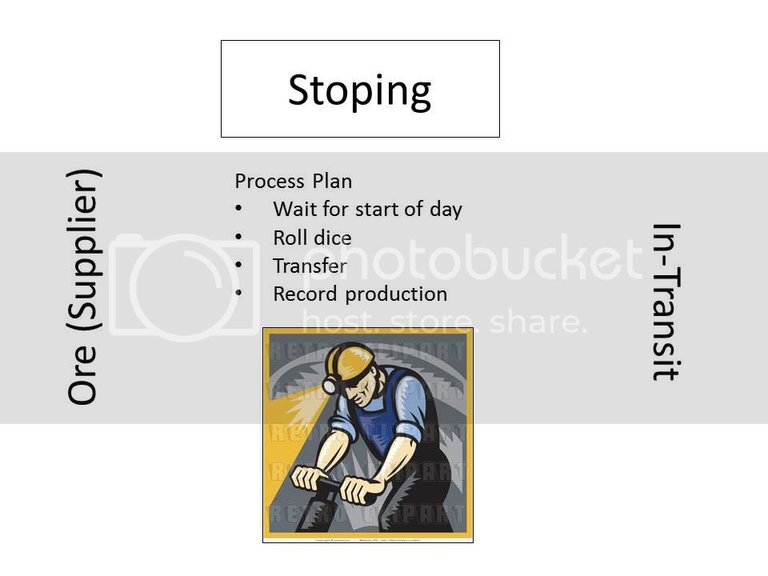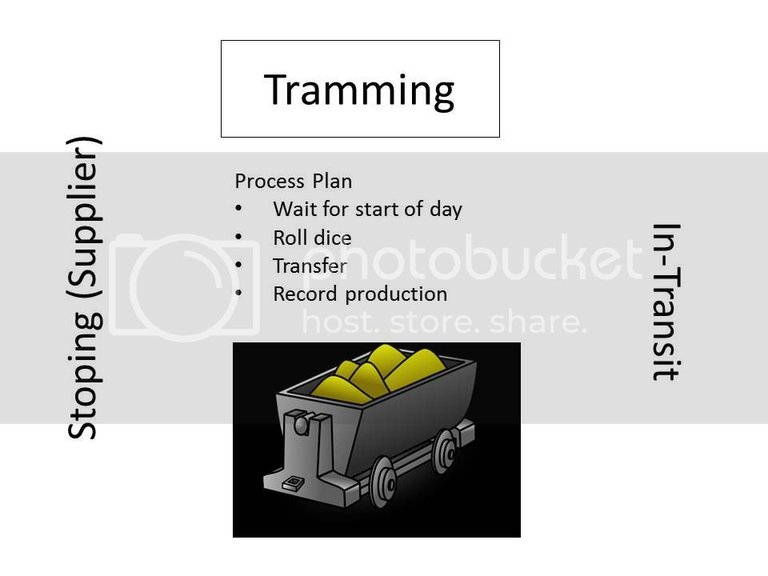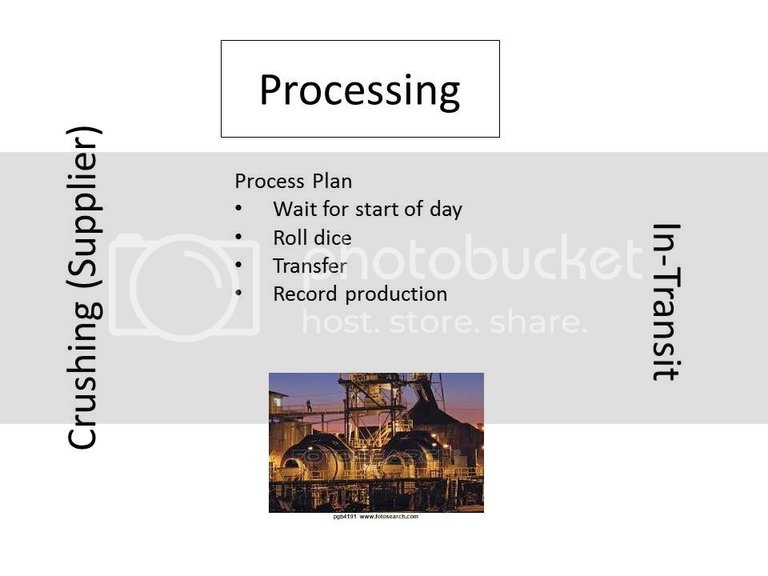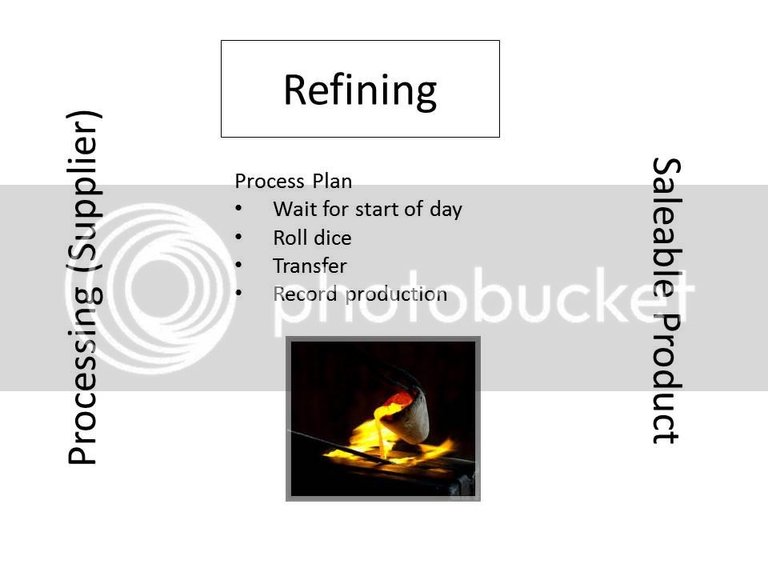
Goldratt's Dice Game is a well-known demonstrator for the Theory of Constraints (TOC) and there are numerous lessons to be learnt - with my personal interest being measuring and rewarding people's performance. (http://www.tocinstitute.org/theory-of-constraints.html). The game basically simulates a system with a product moving through from station to station. A detailed description of the game can be found at the following link: http://pubsonline.informs.org/doi/pdf/10.1287/ited.3.1.20.
In my Mineral Resource Management classes I use the dice game in a mining context. The product can be any ore mined and sold, and typically I use six stations (although this may be reduced to five for smaller class numbers). The product is represented by matchsticks. These stations are Mining, Tramming, Hoisting, Crushing, Milling and Refining.
Unlimited supply of matches >

> Buffer (maximum 6 matches) >

> Buffer (maximum 6 matches) >

> Buffer (maximum 6 matches) >

> Buffer (maximum 6 matches) >

> Buffer (maximum 6 matches) >

> Overall product sold after 20 rounds
A student sits at each of the stations with three counters (matchsticks) between each of the stations. To the left of the Stoping Station are full match boxes, and two the right of the Refining Station are empty match boxes. Once the students are all in their places (the number of students in the class govern the number of games running simultaneously), they are given the instructions as well as their “call”. In the mining industry, the “call” is the required production to receive the “bonus”. Crews who do not achieve their monthly call do not earn a production bonus. Those who exceed their call earn bonus, which is often calculated to increase almost exponentially for crews exceeding the call by significant margins. For the dice game, the call is the average result of 20 throws of a six sided dice (which is 70 – jip the average of 1 + 2 + 3 + 4 + 5 + 6 is 3.5, not 3). The students record their own throws to determine if they achieve their call or not. However, they can only pass the number of matches they have to their left, and they cannot have more than 6 matches between stations at any time (indicating a buffer capacity).
Because the system starts “fully loaded”, the student at the Refining Station throws his/her dice first. The number of matches on the dice indicates the stations daily production. The student can then move that number of matches. If it is less than 3 for the first round, the full amount can be thrown. If it’s more than 3, then only 3 matches can be passed because that’s all that’s available in the proceeding buffer. As the game progresses and the buffers fill up, so more matches can be passed
The game becomes very animated and the students quickly identify who is exceeding the call and those falling below the targets. This is emphasised by myself representing the manager and identifying those falling behind and blaming them for the mine falling down on the overall production.
After the 20 rounds have passed, the number of matches which are to the right of the Refining Station represent the total production for the month. (20 production shifts). After numerous observations running this game (usually three games per class, two to three classes per year), I have never seen a group produce more than 54 matchsticks (units of production). Typically the number falls between 46 to 51 matchsticks. At this point, the individuals who achieved more than 70 for their cumulative throws are rewarded with a chocolate – reward for their production exceeding “call”. Usually more than half the individual students achieve "call", even if only 50% should exceed the target (maybe some "creative counting" on their part).
The post-game discussion is then focused on why the overall system fails to achieve the monthly call when typically over half of the individuals were now eating their chocolates. One of the students usually comment that maybe increasing the buffer capacity (set at 6 matches) would improve the overall production. There are numerous simulations available online and the effect of removing the buffer capacity is demonstrated using one of these It is demonstrated that removing the buffer capacity has actually no measurable difference in the overall production from the system. This is surprise for the students. In reality, increasing buffer capacities on mines is an incredibly expensive exercise requiring extensive capital investment. This is shown by these simulations not to solve production problems from mines.
The system is then reloaded. All the buffers are filled with the three matches and the constraint of six matches is put back into place. The difference with the second run of the game is that individual performance is limited and controlled. If a student throws 1-3 on the dice, they can move three matches. If they throw 4-6 on the dice, they can move four matches. The game proceeds and the first observation is the calm atmosphere in the class room. The students are not required to record their individual throws and so the focus is on the throughput through the entire system. By removing the downside (one and two matches) at the expense of the upside (five or six matches), variability is reduced and the entire system performs better. Typically, the game now results in throughputs of 60-63 matches. Still slightly below the call of seventy matches but significantly better than the previous 46-51 matches typically achieved. There are no individual rewards and so the only measure to be rewarded is the overall performance.
At this point, the students who did not receive chocolates for the previous game are given a chocolate too. The prime learning lesson from the second game is that variability is detrimental to production systems. Individual stations can be made smaller because there is no benefit in overproduction if the following stations cannot process the production. For me however, the observations of people behavior are as significant as the primary learning lesson which is the increased production from the mine. The second game is far less animated than the first game and the room is calm. The students are not focused on their individual throws and these are not even recorded. The only number of concern is the number of matchsticks to the right of the last station. Regarding the lessons from the chocolates. The students who initially received the chocolates admitted they felt a little guilty for receiving a reward when they realise they had done nothing extra to actually receive it. The fact they had received a chocolate was purely due to the "roll of the dice". Those who did not receive the reward were equally unhappy because in their minds they had put in the same effort as those who had received the chocolates. It is important that any reward scheme in the workplace really recognises true extra effort and does not become a "handout" or based on circumstances beyond the control of the recipient.
Taking these lessons into the real world can aid managers in developing key performance indicators. Individual performance should never be rewarded if the overall business fails to achieve the target. The optimum production will always be slightly lower than the average from the individual stations, but by lowering variability, this gap can narrowed. Removing variability can result in significant savings as each station can be made smaller, because excess production does not benefit overall production. Spending capital to increase the sizes of buffers between stations is also fruitless expenditure.

Chamber of Mines building at the University Witwatersrand, Johannesburg.
The author is a lecturer in Mine Financial Valuation and Mineral Resource Management and is reading for a PhD considering cut-off grade optimisation.